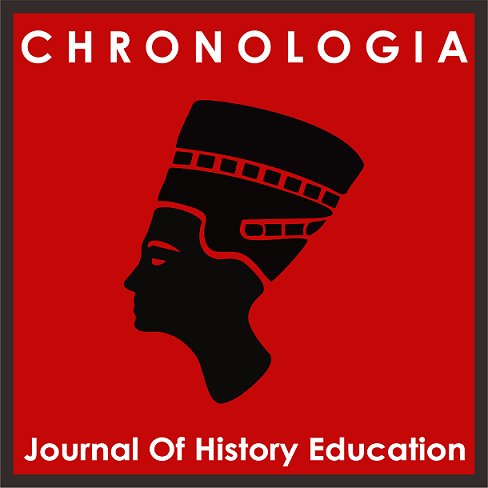Main Article Content
Abstract
The history of the Chinese diaspora to Indonesia is very interesting to discuss. The long process of the arrival of the Chinese community to Indonesia long before the arrival of westerners to Indonesia has formed a separate identity for the Chinese community who in the end had to accept the policy of 'assimilation'. This process is part of the representation of the Chinese community in Indonesia. The Chinese themselves feel that they are different from the natives in all respects, so the feeling of being a minority group is getting stronger. The Chinese increasingly showed their cultural identity after the construction of various facilities such as a special school for the Chinese, a Chinese cultural group, and a Chinese-language newspaper. In order to accommodate these interests and due to the pressure and atmosphere at that time, in 1954 the Indonesian Citizenship Consultative Body (BAPERKI) was formed. This study uses the historical method to explain the role of BAPERKI as a political identity and representation of the Chinese community in Indonesia. The stages that are passed are the heuristic stage (data collection), the critical stage, the interpretation stage and the historiography (historical writing). The increasing role of the Chinese community in Indonesia has caused them to form organizations that can protect their people, who indeed have a minority number. For that purpose, they formed BAPERKI. BAPERKI has a role as a socio-political organization of the Peranakan Chinese group in Indonesia. The issue of citizenship is the background behind the establishment of BAPERKI.
Keywords
Article Details
References
- Ayuningtyas, A. (2007). Baperki (Badan Permusjawaratan Kewarganegaraan Indonesia) organisasi sosial politik Cina peranakan di Indonesia tahun 1954-1966 (Universitas Indonesia). Universitas Indonesia. Retrieved from https://lib.ui.ac.id/detail.jsp?id=20159873
- BAPERKI. Berita BAPERKI. 26 April 1954. (n.d.). p. 1.
- Darini, R. (2011). Kebijakan Negara dan Sentiment Anti-Cina: Perspektif Historis. Mozaik, 2, 1–12. Retrieved from http://staff.uny.ac.id/sites/default/files/penelitian/Ririn Darini, SS.,M.Hum./kebijk neg thd etnis tiong-ISTORIA.pdf
- Davgaf. (2022). Universitas Trisakti. Retrieved December 18, 2021, from Wikipedia website: https://id.wikipedia.org/wiki/Universitas_Trisakti#Universitas_BAPERKI
- Noordjanah, A. (2010). Komunitas Tionghoa di Surabaya. Yogyakarta: Ombak.
- Setiono, B. G. (2002). Tionghoa Indonesia dalam Pusaran Politik. Jakarta: Elkasa.
- Sjamsuddin, H. (2016). Metodologi Sejarah (Cetakan 3; M. Nursam, Ed.). Yogyakarta: Ombak.
- Suhandinata, J. (2009). WNI Keturunan Tionghoa dalam Stabilitas Ekonomi dan Politik Indonesia. Jakarta: PT Gramedia Pustaka Utama.
- Sulistyo, H. (2000). Palu Arit di Ladang Tebu Sejarah Pembantaian Massal yang Terlupakan (Jombang-Kediri 1965-1966) (Cetakan 8). Jakarta: KPG (Keputusan Populer Gramedia).
- Suryadinata, L., & Subono, N. I. (2005). Pemikiran Politik Etnis Tionghoa Indonesia 1900-2002 (Cetakan 1). Jakarta: LP3ES.
- Wikipedia. (2021). Kota Bima. Retrieved from Wikipedia website: https://id.wikipedia.org/w/index.php?title=Kota_Bima&action=history
References
Ayuningtyas, A. (2007). Baperki (Badan Permusjawaratan Kewarganegaraan Indonesia) organisasi sosial politik Cina peranakan di Indonesia tahun 1954-1966 (Universitas Indonesia). Universitas Indonesia. Retrieved from https://lib.ui.ac.id/detail.jsp?id=20159873
BAPERKI. Berita BAPERKI. 26 April 1954. (n.d.). p. 1.
Darini, R. (2011). Kebijakan Negara dan Sentiment Anti-Cina: Perspektif Historis. Mozaik, 2, 1–12. Retrieved from http://staff.uny.ac.id/sites/default/files/penelitian/Ririn Darini, SS.,M.Hum./kebijk neg thd etnis tiong-ISTORIA.pdf
Davgaf. (2022). Universitas Trisakti. Retrieved December 18, 2021, from Wikipedia website: https://id.wikipedia.org/wiki/Universitas_Trisakti#Universitas_BAPERKI
Noordjanah, A. (2010). Komunitas Tionghoa di Surabaya. Yogyakarta: Ombak.
Setiono, B. G. (2002). Tionghoa Indonesia dalam Pusaran Politik. Jakarta: Elkasa.
Sjamsuddin, H. (2016). Metodologi Sejarah (Cetakan 3; M. Nursam, Ed.). Yogyakarta: Ombak.
Suhandinata, J. (2009). WNI Keturunan Tionghoa dalam Stabilitas Ekonomi dan Politik Indonesia. Jakarta: PT Gramedia Pustaka Utama.
Sulistyo, H. (2000). Palu Arit di Ladang Tebu Sejarah Pembantaian Massal yang Terlupakan (Jombang-Kediri 1965-1966) (Cetakan 8). Jakarta: KPG (Keputusan Populer Gramedia).
Suryadinata, L., & Subono, N. I. (2005). Pemikiran Politik Etnis Tionghoa Indonesia 1900-2002 (Cetakan 1). Jakarta: LP3ES.
Wikipedia. (2021). Kota Bima. Retrieved from Wikipedia website: https://id.wikipedia.org/w/index.php?title=Kota_Bima&action=history

